The Palazzo Malvezzi de' Medici is a Renaissance-style palace located on Via Zamboni #13 in central Bologna, Italy. The palace now houses the offices of the Provincial Administration.
Contents

The Palazzo Malvezzi de' Medici is a Renaissance-style palace located on Via Zamboni #13 in central Bologna, Italy. The palace now houses the offices of the Provincial Administration.

Construction of the palace was commissioned in 1560 by the widow of Giovanni di Bartolomeo Malvezzi, Paola di Antonio Maria Campeggi; the design was by Bartolomeo Triachini. The facade rises on the narrow street of San Donato.
In 1725 the Marquis Giuseppe Maria Malvezzi de' Medici (1670–1736) commissioned the design of the scenic staircase from Ferdinando Galli-Bibiena and construction completed by Alfonso Torreggiani. In the mid-nineteenth century, Giovanni Malvezzi (1819–1892), refurbished the palace under the direction of Francesco Cocchi. In 1931 the building was sold by Aldobrandino Malvezzi (1881–1961), professor at the University of Florence, to the Province of Bologna.
The rooms of the main floor maintain much of Cocchi's 19th-century wall decor.
The Sala dello Zodiaco has ceiling frescoes of the zodiac. The room also exhibits the Martyrdom of Saint Eufemia by Gabriele Ferrantini, a Martyrdom of St Ursula by Giacinto Campana, and a St Peter and a St Paul, both 19th-century copies by Andrea Bèsteghi of 17th-century originals by Bartolomeo Cesi.
The Anticamera della sala Consiglio has ceilings frescoed with Minerva and Apollo with the Muses. The Sala di Giunta has ceilings frescoed by Cocchi and two wall canvases respectively depicting Marco Minghetti and Andrea Costa.
The Sala Rosa or degli Amori has a ceiling frescoed by Girolamo Dalpane with scenes from the Decameron . Four images depict images of famous writers and their respective muses: Tasso and Eleonora; Boccaccio and Fiammetta; Dante and Beatrice; and Petrarch and Laura. In eight ovals are depicted with famous women from Italian history: Giulia Gonzaga, Violante Giustiniani, Ginevra Bentivoglio, Beatrice degli Obizzi, Vittoria Colonna, Maria di Monferrato, Bianca Sforza, and Maria d'Aragona.
The Sala Verde has a ceiling depicting Triumph of Bacchus and Ariadne. The walls have two portraits by Carlo Berti Pichat and a copy of Guido Reni's Joseph and the Wife of Potiphar. [1]
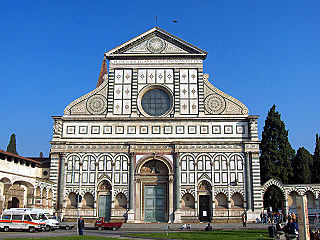
Santa Maria Novella is a church in Florence, Italy, situated opposite, and lending its name to, the city's main railway station. Chronologically, it is the first great basilica in Florence, and is the city's principal Dominican church.
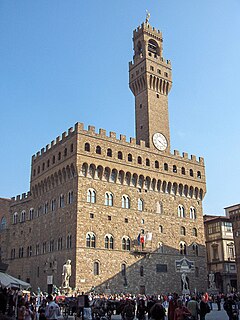
The Palazzo Vecchio is the town hall of Florence, Italy. It overlooks the Piazza della Signoria, which holds a copy of Michelangelo's David statue, and the gallery of statues in the adjacent Loggia dei Lanzi.

Giuseppe Maria Crespi, nicknamed Lo Spagnuolo, was an Italian late Baroque painter of the Bolognese School. His eclectic output includes religious paintings and portraits, but he is now most famous for his genre paintings.

Giovanni Lanfranco was an Italian painter of the Baroque period.

The Palazzo Ducale di Mantova is a group of buildings in Mantua, Lombardy, northern Italy, built between the 14th and the 17th century mainly by the noble family of Gonzaga as their royal residence in the capital of their Duchy. The buildings are connected by corridors and galleries and are enriched by inner courts and wide gardens. The complex includes some 500 rooms and occupies an area of c. 34,000 m², which make it the sixth largest palace in Europe after the palaces of the Vatican, the Louvre Palace, the Palace of Versailles, the Royal Palace of Caserta and the Castle of Fontainebleau. It has more than 500 rooms and contains 7 gardens and 8 courtyards. Although most famous for Mantegna's frescos in the Camera degli Sposi, they have many other very significant architectural and painted elements.
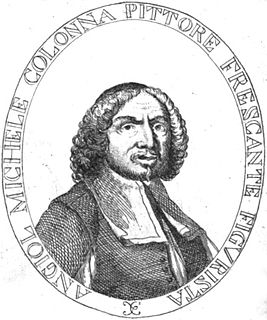
Angelo Michele Colonna was an Italian painter of the Baroque period, active in Bologna, northern and central Italy and Spain. He is sometimes referred to as Michelangelo Colonna.
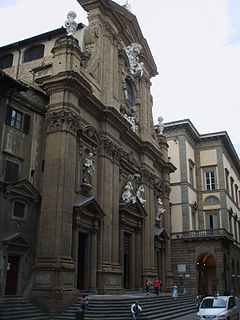
San Gaetano, also known as Santi Michele e Gaetano, is a Baroque church in Florence, Italy, located on the Piazza Antinori.

Pistoia Cathedral is the main religious building of Pistoia, Tuscany, central Italy, located in the Piazza del Duomo in the centre of the city. It is the seat of the Bishop of Pistoia and is dedicated to Saint Zeno of Verona.
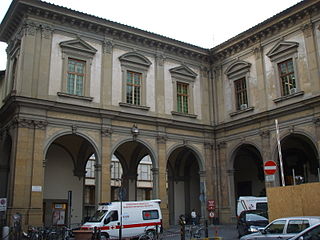
The Hospital of Santa Maria Nuova is the oldest hospital still active in Florence, Italy.

The Basilica of San Giacomo Maggiore is an historic Roman Catholic church in Bologna, region of Emilia Romagna, Italy, serving a monastery of Augustinian friars. It was built starting in 1267 and houses, among the rest, the Bentivoglio Chapel, featuring numerous Renaissance artworks.
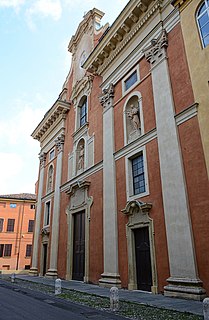
San Bartolomeo is a Baroque church in Modena.
Giovanni Luigi Malvezzi de’ Medici was a politician, patriot, and Italian scholar.

San Procolo is an early Gothic-style, Roman Catholic church and former monastery-hospital located on Via Massimo D'Azeglio #52 in central Bologna, region of Emilia Romagna, Italy.

Santi Bartolomeo e Gaetano is a Renaissance style, Roman Catholic church in central Bologna; it is located near the Due Torri adjacent to the Strada Maggiore.

Volterra Cathedral is a Roman Catholic cathedral in Volterra, Italy, dedicated to the Assumption of the Virgin Mary. It is the seat of the bishop of Volterra.
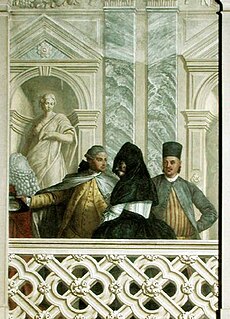
Michelangelo Morlaiter was an Italian painter, active mainly in Venice. He was one of the founding members and professor of the Accademia di Scoltura, Pittura, ed Architettura Civile in Venice in 1766.

The Oratory of Saints Cecilia and Valeriano is a religious site in central Bologna, found on Via Zamboni, contiguous to the portico of the church of San Giacomo Maggiore.
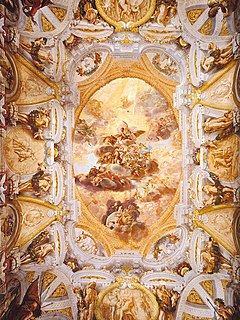
The Palazzo Pepoli Campogrande, also known as Palazzo Pepoli Nuovo, is a Baroque style palace on Via Castiglione 7 in central Bologna, region of Emilia-Romagna, Italy. In 2015, it served as a public art gallery for late-Baroque art. Across the Via, rises the medieval Palazzo Pepoli Vecchio, also once pertaining to the same family, which now serves as a museum of the history of Bologna.

Palazzo Malvezzi Campeggi is a Renaissance palace located on Via Zamboni number 22, at the corner (southwest) with Via Marsala, in central Bologna, region of Emilia Romagna, Italy. It stands across from San Giacomo Maggiore, and just northeast of the Palazzo Magnani. It presently houses the Law Faculty of the University of Bologna.

The Galleria Giorgio Franchetti alla Ca' d'Oro is an intimate art museum located in the picturesque Ca' d'Oro on the Grand Canal in Venice, Italy.